Erection date: 1672
Site: Temple Bar (5 memorials)
EC4, Paternoster Square
We found the following at Discovering Dickens
"An 18th-century account of it, from Harrison’s New and Universal History, Description and Survey of ... London (1776): This is a very handsome and noble gate, with a postern on each side for the convenience of foot-passengers. It is built entirely of Portland stone, of rustic work below, and of the Corinthian order. The great arch is elliptical, and very flat, and the whole forms a very elegant appearance. Over the gateway, on the east side, in two niches, are stone statues of queen Elizabeth {we believe this is incorrect and the statue is actually of James's consort, Anne of Denmark} and king James I with the king’s arms over the keystone; and on the west side are the statues of king Charles I and king Charles II in Roman habits."
For more on its history see Temple Bar.
With the Temple Bar in its new location the statues are arranged as follows:
On the north face:
North face, to the left - Anne of Denmark
North face, to the right - King James I
South face, to the left - King Charles I
South face, to the right - King Charles II
What is it with theses monarchs - they won't look you in the eye? Except for Charles II, and he is looking exceptionally ugly. These four statues are the originals. Other carvings on the monument had been lost and were recreated by Tim Crawley as part of the 2004 restoration.
Note: the tall column at the centre of the Square carries no inscription but is rumoured to be a memorial to the 20,000 or 6 million (numbers vary, and how can anyone know anyway?) books lost in the London Blitz, this being a centre of the printing trade at the time. We can find no official statement of this and will not honour the monument with its own entry in London Remembers until we do. The 23 metre column was designed by the architects for the whole Square, Whitfield Partners, and it is said to be a recreation of one of the Inigo Jones columns on the previous St Paul’s Cathedral, lost in the Great Fire. More functionally, it cleverly conceals a ventilation shaft to the service road below.













Comments are provided by Facebook, please ensure you are signed in here to see them